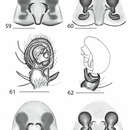Description
provided by Zookeys
Male (holotype):Color: carapace uniformly yellow-brown; sternum pale yellow-brown; chelicerae pale yellow with darker infuscations anteriorly; maxillae pale yellow-brown; labium pale brown; abdomen dorsally yellow-brown with red-brown and grey markings; ventrally pale yellow-brown; legs with all segments clearly annulated. Cephalothorax:setae short, stout, rodlike; 0.9 times longer than broad; fovea longitudinal, broad, very shallow. Eyes:AER slightly recurved; PER recurved; PME larger than AME, PLE largest, ALE smallest; eye group width 1.2; eye diameters, AME 0.15, ALE 0.09, PME 0.18, PLE 0.24; interdistances AME-ALE 0.21, PME-PLE 0.21, ALE-PLE 0.18, AME-PME 0.03; ocular quadrangle AME-AME 0.38, PME-PME 0.66; clypeus 0.07 high. Mouthparts:chelicerae with a few stout setae medially and anteriorly; lateral boss present, smooth; promargin with 3 teeth, retromargin with 2 teeth; maxillae longer than broad, with tuft of conspicuous setae distally; labium distally rounded. Sternum: 0.79 times longer than broad, posteriorly indented. Pedipalp: femur, spination dorsal 0–1–1; retrolateral tibial apophysis with 2 processes, dorsal process directed laterally, pointed at tip, blade like in ventral view, ventral process larger, flattened and subquadrangular at tip; retrolateral basal cymbial process present; cymbial scopulae absent, cymbium oval. Conductor large, sinuous along anterior margin, tip pointed, curved distally; embolus long and slender, arising from oblong base, tapering, hooked beginning at 6 o’clock, terminating at 2 o’clock; MA with quadrate to oval base with two processes, one directed laterally, one distally (Figs 61–62). Legs:leg I much shorter than legs II, III and IV; leg formula 3241; scopulae absent on all legs; tarsus I–IV with strong claw tufts; pr claws with 1 or 2 small teeth; spination: leg I, Fm pr 1–1–0, d 1–1–1, rl 0; Ti d 0, v 2–2–2–2–2; Mt v 2–2–2; Ti and Mt I and II with weak spines; leg II, Fm pr 0, d 1–1–1, rl 0; Ti v 2–2–2–2–2; Mt v 2–2–2; leg III, Fm pr 0, d 1–1–1, rl 0; Ti 0; Mt 0; leg IV, Fm pr 0, d 1–1–1, rl 0; Ti 0; Mt 0. Abdomen:without terminal setal tufts.Dimensions:Total length 3.99. Cephalothorax length 2.20, width 2.45. Sternum length 1.10, width 1.40. Abdomen length 2.03, width 2.03. Pedipalp: Fm 0.66, Pt 0.42, Ti 0.36, Ta 0.62, (total) 2.06. Leg I: Fm 3.21, Pt 1.15, Ti 2.87, Mt 2.44, Ta 1.25, (total) 10.92. Leg II: Fm 4.21, Pt 1.25, Ti 3.55, Mt 3.01, Ta 1.38, (total) 13.40. Leg III: Fm 4.60, Pt 1.25, Ti 3.76, Mt 3.14, Ta 1.44, (total) 14.19. Leg IV: Fm 4.26, Pt 1.10, Ti 3.43, Mt 3.12, Ta 1.41, (total) 13.32.
Female (paratype):Color: carapace yellow-brown, with slightly darker marks medially; sternum pale yellow-brown; chelicerae pale yellow with darker infuscations anteriorly; maxillae pale yellow-brown; labium pale brown; abdomen dorsally yellow-brown with red-brown and grey markings; ventrally pale yellow-brown; legs with all segments clearly annulated. Cephalothorax: setae short, stout, rodlike; 0.84 times longer than broad; fovea longitudinal, broad, very shallow. Eyes:AER slightly recurved; PER recurved; PME larger than AME, PLE largest, ALE smallest; eye group width 1.64; eye diameters, AME 0.18, ALE 0.14, PME 0.22, PLE 0.31; interdistances AME-ALE 0.31, PME-PLE 0.30, ALE-PLE 0.21, AME-PME 0.05; ocular quadrangle AME-AME 0.49, PME-PME 0.90; clypeus 0.1 high. Mouthparts:chelicerae with a few stout setae medially and anteriorly; lateral boss present, smooth; promargin with 3 teeth, retromargin with 2 teeth; maxillae longer than broad, with tuft of conspicuous setae distally; labium distally rounded. Sternum:0.77 times longer than broad, posteriorly indented. Pedipalp:tarsus slightly swollen, claw present, with c. 6 teeth. Legs:leg I only slightly shorter than legs II, III and IV; leg formula 3421; scopulae absent on all legs; tarsus I–IV with strong claw tufts; claws without teeth; spination: leg I, Fm pr 1–1–0, d 1–1–1, rl 0; Ti d 0, v 2–2–2–2–2; Mt v 2–2–2; Ti and Mt I and II with strong spines; leg II, Fm pr 0, d 1–1–1, rl 0; Ti v 2–2–2–2–2; Mt v 2–2–2; leg III, Fm pr 0, d 1–1–1, rl 0; Ti 0; Mt 0; leg IV, Fm pr 0, d 1–1–1, rl 0; Ti 0; Mt 0. Abdomen:without tufts of setae. Epigyne:lateral lobes nearly touching posteriorly, separated by keyhole-shaped median area, widening medially, anterolateral edges strongly sclerotized, copulatory openings located under these, epigynal pockets absent; internally small ducts connect to round, well-separated spermathecae, fertilization ducts located posteriorly, posterodorsal fold absent (Figs 63–64).Dimensions:Total length 7.14. Cephalothorax length 2.81, width 3.33. Sternum length 1.40, width 1.83. Abdomen length 4.37, width 4.11. Pedipalp: Fm 0.99, Pt 0.56, Ti 0.58, Ta 0.90, (total) 3.03. Leg I: Fm 3.28, Pt 1.44, Ti 2.86, Mt 2.27, Ta 1.14, (total) 10.99. Leg II: Fm 4.20, Pt 1.54, Ti 3.17, Mt 2.70, ta 1.25, (total) 12.86. Leg III: Fm 4.60, Pt 1.56, Ti 3.64, Mt 3.02, Ta 1.32, (total) 14.14. Leg IV: Fm 4.29, Pt 1.33, Ti 3.28, Mt 2.88, Ta 1.23, (total) 13.01.
- license
- cc-by-3.0
- copyright
- Sarah C. Crews, Mark S. Harvey
- bibliographic citation
- Crews S, Harvey M (2011) The spider family Selenopidae (Arachnida, Araneae) in Australasia and the Oriental Region ZooKeys 99: 1–104
- author
- Sarah C. Crews
- author
- Mark S. Harvey

